Spatial Pattern of the Walkability Index, Walk Score and Walk Score Modification for Elderly
Abstract
1. Introduction
2. Background
- Environmental (statistical) based indicators—calculate local urban characteristics related to walking potential. No distances are taken into account and certain relative measures of neighbourhood conditions such as ratios are applied.
- Accessibility based indicators—evaluate travel parameters in a road network to selected destinations.
3. Configuration of Indicators
4. Materials and Methods
4.1. WAI
4.2. Walk Score
4.3. Walk Score for Elderly
5. Results
5.1. Comparison of WAI and Standard WS for Equivalent Spatial Units
5.2. Comparison between Standard WS and WS for the Elderly
5.3. Sensitivity Analysis of WS for Elderly
- Changing DDF shape and walking speed.
- 2.
- Changing weights for each type of destination.
6. Discussion
7. Conclusions
Supplementary Materials
Author Contributions
Funding
Institutional Review Board Statement
Conflicts of Interest
References
- Wendel-Vos, W.; Droomers, M.; Kremers, S.; Brug, J.; Van Lenthe, F. Potential environmental determinants of physical activity in adults: A systematic review. Obes. Rev. 2007, 8, 425–440. [Google Scholar] [CrossRef] [PubMed]
- Mathers, C.D.; Stevenson, C.E.; Vos, E.T.; Begg, S.J. The Australian Burden of Disease Study: Measuring the loss of health from diseases, injuries and risk factors. Med. J. Aust. 2000, 172, 592–596. [Google Scholar] [CrossRef] [PubMed]
- Yen, I.H.; Anderson, L.A. Built Environment and Mobility of Older Adults: Important Policy and Practice Efforts. J. Am. Geriatr. Soc. 2012, 60, 951–956. [Google Scholar] [CrossRef] [PubMed]
- Kenyon, A.; Pearce, J. The socio-spatial distribution of walkable environments in urban Scotland: A case study from Glasgow and Edinburgh. SSM Popul. Health 2019, 9, 100461. [Google Scholar] [CrossRef] [PubMed]
- Riva, M.; Gauvin, L.; Apparicio, P.; Brodeur, J.-M. Disentangling the relative influence of built and socioeconomic environments on walking: The contribution of areas homogenous along exposures of interest. Soc. Sci. Med. 2009, 69, 1296–1305. [Google Scholar] [CrossRef]
- Hawkes, T.D.; Siu, K.-C.; Silsupadol, P.; Woollacott, M.H. Why does older adults’ balance become less stable when walking and performing a secondary task? Examination of attentional switching abilities. Gait Posture 2012, 35, 159–163. [Google Scholar] [CrossRef][Green Version]
- Webber, M.S.C.; Porter, M.M.; Menec, V.H. Mobility in Older Adults: A Comprehensive Framework. Gerontologist 2010, 50, 443–450. [Google Scholar] [CrossRef]
- Burlando, C.; Cusano, I. Growing Old and Keep Mobile in Italy. Active Ageing and the Importance of Urban Mobility Planning Strategies. Tema J. Land Use Mobil. Environ. 2018, 2, 43–52. [Google Scholar] [CrossRef]
- Peace, S.M.; Kellaher, L.A.; Holland, C. Environment and Identity in Later Life; Open University Press: Maidenhead, UK; New York, NY, USA, 2006. [Google Scholar]
- Vidovićová, L. Stáří ve Městě, Město v Životě Seniorů. Sociologické Nakladatelstvi (SLON); Masarykova Univerzita: Praha, Czech Republic; Brno, Czech Republic, 2013. [Google Scholar]
- Marcellini, F.; Principi, A.; Ciarrocchi, S.; Mollenkopf, H.; Tacken, M.; Ruoppila, I.; Szeman, Z. Mobility Aspects of Older People in Europe: Main Findings of the European Project “Mobilate”. Eur. J. Ageing 2004, 1, 45–53. [Google Scholar]
- Ramezani, S.; Laatikainen, T.; Hasanzadeh, K.; Kyttä, M. Shopping trip mode choice of older adults: An application of activity space and hybrid choice models in understanding the effects of built environment and personal goals. Transportation 2019, 48, 505–536. [Google Scholar] [CrossRef]
- Verbrugge, L.M.; Jette, A. The disablement process. Soc. Sci. Med. 1994, 38, 1–14. [Google Scholar] [CrossRef]
- Vidovićová, L.; Gregorová, E. Nová města a staří lidé. Sociální Studia Soc. Stud. 2010, 7, 81–93. [Google Scholar] [CrossRef]
- Haustein, S. Mobility behavior of the elderly: An attitude-based segmentation approach for a heterogeneous target group. Transportation 2011, 39, 1079–1103. [Google Scholar] [CrossRef]
- Naumann, L.P.; Vazire, S.; Rentfrow, P.J.; Gosling, S. Personality Judgments Based on Physical Appearance. Pers. Soc. Psychol. Bull. 2009, 35, 1661–1671. [Google Scholar] [CrossRef]
- Wang, J.; Cao, X. Exploring built environment correlates of walking distance of transit egress in the Twin Cities. J. Transp. Geogr. 2017, 64, 132–138. [Google Scholar] [CrossRef]
- Stehlíková, J.; Řezník, T. An accessible Brno city centre for people with impaired mobility. J. Maps 2018, 14, 81–87. [Google Scholar] [CrossRef]
- Alves, F.; Cruz, S.; Ribeiro, A.; Silva, A.B.; Martins, J.; Cunha, I. Walkability Index for Elderly Health: A Proposal. Sustainability 2020, 12, 7360. [Google Scholar] [CrossRef]
- Feng, L.; Shi, Z.; Xie, J.; Ma, B.; Chen, X. Enhancer of polycomb maintains germline activity and genome integrity in Drosophila testis. Cell Death Differ. 2018, 25, 1486–1502. [Google Scholar] [CrossRef]
- Meşhur, H.F.A. Evaluation of Urban Spaces from the Perspective of Universal Design Principles: The Case of Konya/Turkey. TeMA J. Land Use Mobil. Environ. 2016, 9, 191–208. [Google Scholar]
- Elsawahli, H.; Ahmad, F.; Ali, A.S. New urbanism design principles and young elderly active lifestyle: An analysis of TTDI neighbourhood in Kuala Lumpur, Malaysia. Urban Des. Int. 2013, 19, 249–258. [Google Scholar] [CrossRef]
- Wu, H.-C.; Tseng, M.-H. Evaluating Disparities in Elderly Community Care Resources: Using a Geographic Accessibility and Inequality Index. Int. J. Environ. Res. Public Health 2018, 15, 1353. [Google Scholar] [CrossRef]
- Van Cauwenberg, J.; De Bourdeaudhuij, I.; De Meester, F.; Van Dyck, D.; Salmon, J.; Clarys, P.; Deforche, B. Relationship between the physical environment and physical activity in older adults: A systematic review. Health Place 2011, 17, 458–469. [Google Scholar] [CrossRef] [PubMed]
- Zhang, J.; Tan, P.Y.; Zeng, H.; Zhang, Y. Walkability Assessment in a Rapidly Urbanizing City and Its Relationship with Residential Estate Value. Sustainability 2019, 11, 2205. [Google Scholar] [CrossRef]
- Gaglione, F.; Gargiulo, C.; Zucaro, F. Elders’ quality of life. A method to optimize pedestrian accessibility to urban services. Tema J. Land Use Mobil. Environ. 2019, 3, 295–312. [Google Scholar] [CrossRef]
- Gharaveis, A. A systematic framework for understanding environmental design influences on physical activity in the elderly population. Facilities 2020, 38, 625–649. [Google Scholar] [CrossRef]
- Reyer, M.; Fina, S.; Siedentop, S.; Schlicht, W. Walkability is Only Part of the Story: Walking for Transportation in Stuttgart, Germany. Int. J. Environ. Res. Public Health 2014, 11, 5849–5865. [Google Scholar] [CrossRef] [PubMed]
- Riggs, W.; Sethi, S.A. Multimodal travel behaviour, walkability indices, and social mobility: How neighbourhood walkability, income and household characteristics guide walking, biking & transit decisions. Local Environ. 2020, 25, 57–68. [Google Scholar] [CrossRef]
- Ewing, R.; Cervero, R. Travel and the Built Environment: A meta-analysis. J. Am. Plan. Assoc. 2010, 76, 265–294. [Google Scholar] [CrossRef]
- Heath, G.W.; Brownson, R.C.; Kruger, J.; Miles, R.; Powell, K.E.; Ramsey, L.T. The Effectiveness of Urban Design and Land Use and Transport Policies and Practices to Increase Physical Activity: A Systematic Review. J. Phys. Act. Health 2006, 3, S55–S76. [Google Scholar] [CrossRef]
- Saelens, B.E.; Sallis, J.F.; Frank, L.D. Environmental correlates of walking and cycling: Findings from the transportation, urban design, and planning literatures. Ann. Behav. Med. 2003, 25, 80–91. [Google Scholar] [CrossRef]
- Hanson, S.; Berkowitz, B.A.; Ainsworth, B.E.; Blair, S.N.; Cervero, R.B.; Chen, D.D.T.; Crane, R.; Fullilove, M.T.; Giuliano, G.; Lawton, T.K.; et al. Does the Built Environment Influence Physical Activity? Transportation Research Board: Washington, DC, USA, 2005. [Google Scholar]
- Cerin, E.; Saelens, B.E.; Sallis, J.F.; Frank, L.D. Neighborhood Environment Walkability Scale: Validity and Development of a Short Form. Med. Sci. Sports Exerc. 2006, 38, 1682–1691. [Google Scholar] [CrossRef] [PubMed]
- Arentze, T.T.; Timmermans, H.H. Social Networks, Social Interactions, and Activity-Travel Behavior: A Framework for Microsimulation. Environ. Plan. B Plan. Des. 2008, 35, 1012–1027. [Google Scholar] [CrossRef]
- Frochen, S.; Ailshire, J.; Rodnyansky, S. Residential Care in Los Angeles: Evaluating the spatial distribution of facilities and neighbourhood access to care among older adults. Local Environ. 2019, 24, 274–288. [Google Scholar] [CrossRef] [PubMed]
- Padeiro, M. Geographical accessibility to community pharmacies by the elderly in metropolitan Lisbon. Res. Soc. Adm. Pharm. 2018, 14, 653–662. [Google Scholar] [CrossRef] [PubMed]
- Bruns, C.R.; Chamberlain, B. The influence of landmarks and urban form on cognitive maps using virtual reality. Landsc. Urban Plan. 2019, 189, 296–306. [Google Scholar] [CrossRef]
- Filomena, G.; Manley, E.; Verstegen, J.A. Perception of urban subdivisions in pedestrian movement simulation. PLoS ONE 2020, 15, e0244099. [Google Scholar] [CrossRef]
- Pafka, E.; Dovey, K. Permeability and interface catchment: Measuring and mapping walkable access. J. Urban. Int. Res. Placemaking Urban Sustain. 2016, 10, 150–162. [Google Scholar] [CrossRef]
- Horton, F.E.; Reynolds, D.R. Effects of Urban Spatial Structure on Individual Behavior. Econ. Geogr. 1971, 47, 36. [Google Scholar] [CrossRef]
- Deng, C.; Dong, X.; Wang, H.; Lin, W.; Wen, H.; Frazier, J.; Ho, H.C.; Holmes, L. A Data-Driven Framework for Walkability Measurement with Open Data: A Case Study of Triple Cities, New York. ISPRS Int. J. Geo-Inf. 2020, 9, 36. [Google Scholar] [CrossRef]
- Bielik, M.; König, R.; Schneider, S.; Varoudis, T. Measuring the Impact of Street Network Configuration on the Accessibility to People and Walking Attractors. Netw. Spat. Econ. 2018, 18, 657–676. [Google Scholar] [CrossRef]
- Dovey, K.; Pafka, E. What is walkability? The urban DMA. Urban Stud. 2019, 57, 93–108. [Google Scholar] [CrossRef]
- Moura, F.; Cambra, P.; Gonçalves, A.B. Measuring walkability for distinct pedestrian groups with a participatory assessment method: A case study in Lisbon. Landsc. Urban Plan. 2017, 157, 282–296. [Google Scholar] [CrossRef]
- Vale, D.S.; Saraiva, M.; Pereira, M. Active accessibility: A review of operational measures of walking and cycling accessibility. J. Transp. Land Use 2015, 9, 209–235. [Google Scholar] [CrossRef]
- Kim, E.J.; Kim, Y.-J. A Reliability Check of Walkability Indices in Seoul, Korea. Sustainability 2019, 12, 176. [Google Scholar] [CrossRef]
- Lefebvre-Ropars, G.; Morency, C. Walkability: Which Measure to Choose, Where to Measure It, and How? Transp. Res. Rec. J. Transp. Res. Board 2018, 2672, 139–150. [Google Scholar] [CrossRef]
- Mooney, S.J.; Hurvitz, P.M.; Moudon, A.V.; Zhou, C.; Dalmat, R.; Saelens, B.E. Residential neighborhood features associated with objectively measured walking near home: Revisiting walkability using the Automatic Context Measurement Tool (ACMT). Health Place 2020, 63, 102332. [Google Scholar] [CrossRef]
- Shashank, A.; Schuurman, N. Unpacking walkability indices and their inherent assumptions. Health Place 2018, 55, 145–154. [Google Scholar] [CrossRef]
- Leão, A.L.F.; Urbano, M.R. Street connectivity and walking: An empirical study in Londrina-PR. Semin. Ciências Exatas Tecnológicas 2020, 41, 31–42. [Google Scholar] [CrossRef]
- Cervero, R.; Kockelman, K. Travel demand and the 3Ds: Density, diversity, and design. Transp. Res. Part D Transp. Environ. 1997, 2, 199–219. [Google Scholar] [CrossRef]
- Wong, B.Y.-M.; Faulkner, G.; Buliung, R. GIS measured environmental correlates of active school transport: A systematic review of 14 studies. Int. J. Behav. Nutr. Phys. Act. 2011, 8, 39. [Google Scholar] [CrossRef]
- Zhang, W.; Lu, D.; Zhao, Y.; Luo, X.; Yin, J. Incorporating polycentric development and neighborhood life-circle planning for reducing driving in Beijing: Nonlinear and threshold analysis. Cities 2021, 121, 103488. [Google Scholar] [CrossRef]
- Al Shammas, T.; Escobar, F. Comfort and Time-Based Walkability Index Design: A GIS-Based Proposal. Int. J. Environ. Res. Public Health 2019, 16, 2850. [Google Scholar] [CrossRef] [PubMed]
- Zhu, X.; Lee, C. Walkability and Safety Around Elementary Schools: Economic and Ethnic Disparities. Am. J. Prev. Med. 2008, 34, 282–290. [Google Scholar] [CrossRef] [PubMed]
- Golan, Y.; Wilkinson, N.; Henderson, J.M.; Weverka, A. Gendered walkability: Building a daytime walkability index for women. J. Transp. Land Use 2019, 12, 501–526. [Google Scholar] [CrossRef]
- Lee, S.; Lee, C.; Nam, J.W.; Abbey-Lambertz, M.; Mendoza, J.A. School walkability index: Application of environmental audit tool and GIS. J. Transp. Health 2020, 18, 100880. [Google Scholar] [CrossRef] [PubMed]
- Hajna, S.; Dasgupta, K.; Halparin, M.; Ross, N.A. Neighborhood Walkability. Am. J. Prev. Med. 2013, 44, e55–e59. [Google Scholar] [CrossRef]
- Lin, L.; Moudon, A.V. Objective versus subjective measures of the built environment, which are most effective in capturing associations with walking? Health Place 2009, 16, 339–348. [Google Scholar] [CrossRef]
- Tiran, J.; Lakner, M.; Drobne, S. Modelling walking accessibility: A case study of Ljubljana, Slovenia. Morav. Geogr. Rep. 2019, 27, 194–206. [Google Scholar] [CrossRef]
- Handy, S. Is accessibility an idea whose time has finally come? Transp. Res. Part D Transp. Environ. 2020, 83, 102319. [Google Scholar] [CrossRef]
- Zhang, W.; Zhao, Y.; Cao, X.; Lu, D.; Chai, Y. Nonlinear effect of accessibility on car ownership in Beijing: Pedestrian-scale neighborhood planning. Transp. Res. Part D Transp. Environ. 2020, 86, 102445. [Google Scholar] [CrossRef]
- Frank, L.D.; Sallis, J.F.; Saelens, B.E.; Leary, L.; Cain, K.; Conway, T.L.; Hess, P.M. The development of a walkability index: Application to the Neighborhood Quality of Life Study. Br. J. Sports Med. 2010, 44, 924–933. [Google Scholar] [CrossRef] [PubMed]
- Arellana, J.; Saltarín, M.; Larrañaga, A.M.; Alvarez, V.; Henao, C.A. Urban walkability considering pedestrians’ perceptions of the built environment: A 10-year review and a case study in a Medium-sized city in Latin America. Transp. Rev. 2020, 40, 183–203. [Google Scholar] [CrossRef]
- Kim, E.J.; Kim, J.; Kim, H. Does Environmental Walkability Matter? The Role of Walkable Environment in Active Commuting. Int. J. Environ. Res. Public Health 2020, 17, 1261. [Google Scholar] [CrossRef] [PubMed]
- Watson, K.B.; Whitfield, G.P.; Thomas, J.V.; Berrigan, D.; Fulton, J.E.; Carlson, S.A. Associations between the National Walkability Index and walking among US Adults—National Health Interview Survey, 2015. Prev. Med. 2020, 137, 106122. [Google Scholar] [CrossRef] [PubMed]
- Find Apartments for Rent and Rentals-Get Your Walk Score. Available online: http://walkscore.com (accessed on 24 April 2022).
- Buck, C.; Pohlabeln, H.; Huybrechts, I.; De Bourdeaudhuij, I.; Pitsiladis, Y.; Reisch, L.; Pigeot, I. Development and application of a moveability index to quantify possibilities for physical activity in the built environment of children. Health Place 2011, 17, 1191–1201. [Google Scholar] [CrossRef]
- Singleton, P.; Muhs, C.; Schneider, R.; Clifton, K. Predicting Walking Trips: The Pedestrian Index of the Environment (PIE). In Proceedings of the Pro Walk/Pro Bike/Pro Place Conference, Pittsburgh, PA, USA, 11–18 September 2014. [Google Scholar]
- Witten, K.; Pearce, J.; Day, P. Neighbourhood Destination Accessibility Index: A GIS Tool for Measuring Infrastructure Support for Neighbourhood Physical Activity. Environ. Plan. A Econ. Space 2011, 43, 205–223. [Google Scholar] [CrossRef]
- Mukhtar, M.; Guillette, D.; Lapos, N.; Fitzpatrick, S.; Jaros, R. An Objective Walkability Index for Public Health and Planning in Peel Region, Ontario, Canada. Prev. Chronic Dis. 2019, 16, 180469. [Google Scholar] [CrossRef]
- Clifton, K.J.; Singleton, P.; Muhs, C.D.; Schneider, R.J. Representing pedestrian activity in travel demand models: Framework and application. J. Transp. Geogr. 2016, 52, 111–122. [Google Scholar] [CrossRef]
- ILS-Monitoring Stadtregionen. Available online: https://ils-stadtregionen.de/ (accessed on 24 April 2022).
- Lawhon, L.L. Neighborhood Unit. In Encyclopedia of Quality of Life and Well-Being Research; Springer: Dordrecht, The Netherlands, 2014; pp. 4335–4337. [Google Scholar]
- Hirsch, J.A.; Moore, K.A.; Evenson, K.R.; Rodriguez, D.A.; Roux, A.V.D. Walk Score® and Transit Score® and Walking in the Multi-Ethnic Study of Atherosclerosis. Am. J. Prev. Med. 2013, 45, 158–166. [Google Scholar] [CrossRef]
- Chudyk, A.M.; Winters, M.; Moniruzzaman, M.D.; Ashe, M.C.; Gould, J.S.; McKay, H. Destinations matter: The association between where older adults live and their travel behavior. J. Transp. Health 2014, 2, 50–57. [Google Scholar] [CrossRef]
- Chiu, M.; Shah, B.R.; Maclagan, L.C.; Rezai, M.-R.; Austin, P.C.; Tu, J. v Walk Score® and the Prevalence of Utilitarian Walking and Obesity among Ontario Adults: A Cross-Sectional Study. Health Rep. 2015, 26, 3–10. [Google Scholar] [PubMed]
- Kuzmyak, J.R.; Baber, C.; Savory, D. Use of Walk Opportunities Index to Quantify Local Accessibility. Transp. Res. Rec. J. Transp. Res. Board 2006, 1977, 145–153. [Google Scholar] [CrossRef]
- Chen, Y.; Bouferguene, A.; Li, H.; Liu, H.; Shen, Y.; Al-Hussein, M. Spatial gaps in urban public transport supply and demand from the perspective of sustainability. J. Clean. Prod. 2018, 195, 1237–1248. [Google Scholar] [CrossRef]
- Burton, E.; Mitchell, L. Inclusive Urban Design: Streets for Life; Routledge: Oxford, UK, 2006; ISBN 978-0750664585. [Google Scholar]
- Horák, J.; Burian, J.; Ivan, I.; Zajíčková, L.; Tesla, J.; Voženílek, V.; Fojtík, D.; Inspektor, T.; Rypka, M. Prostorové Simulační Modelování Dopravní Dostupnosti; Česká Geografická Společnost: Praha, Czech Republic, 2019; ISBN 978-80-907728-0-9. [Google Scholar]
- Walk Score Methodology Walk Score. 2011. Available online: http://pubs.cedeus.cl/omeka/files/original/b6fa690993d59007784a7a26804d42be.pdf (accessed on 24 April 2022).
- AlShareef, F.; Aljoufie, M. Identification of the Proper Criteria Set for Neighborhood Walkability Using the Fuzzy Analytic Hierarchy Process Model: A Case Study in Jeddah, Saudi Arabia. Sustainability 2020, 12, 9286. [Google Scholar] [CrossRef]
- Carr, L.J.; Dunsiger, S.I.; Marcus, B.H. Validation of Walk Score for estimating access to walkable amenities. Br. J. Sports Med. 2011, 45, 1144–1148. [Google Scholar] [CrossRef] [PubMed]
- Vale, D.S.; Pereira, M. The influence of the impedance function on gravity-based pedestrian accessibility measures: A comparative analysis. Environ. Plan. B Urban Anal. City Sci. 2016, 44, 740–763. [Google Scholar] [CrossRef]
- Kwan, M.-P. Space-Time and Integral Measures of Individual Accessibility: A Comparative Analysis Using a Point-based Framework. Geogr. Anal. 2010, 30, 191–216. [Google Scholar] [CrossRef]
- Guida, C.; Carpentieri, G. Quality of life in the urban environment and primary health services for the elderly during the Covid-19 pandemic: An application to the city of Milan (Italy). Cities 2020, 110, 103038. [Google Scholar] [CrossRef]
- Bauer, J.; Groneberg, D.A. Measuring Spatial Accessibility of Health Care Providers–Introduction of a Variable Distance Decay Function within the Floating Catchment Area (FCA) Method. PLoS ONE 2016, 11, e0159148. [Google Scholar] [CrossRef]
- Dobešová, Z.; Křivka, T. Walkability Index in the Urban Planning: A Case Study in Olomouc City. In Advances in Spatial Planning; InTech: London, UK, 2012. [Google Scholar]
- PavelKVSB/Walkscore-WAI-Walkability: Adaptation of the Walkscore Methodology in the European Environment-Two Versions were Implemented: Classic Walkscore and Walkscore for the Elderly. WAI Adaptation for Overlapping Input Regions. Available online: https://github.com/PavelKVSB/Walkscore-WAI-walkability.git (accessed on 24 April 2022).
- Foti, F.; Waddell, P.; Luxen, D. A Generalized Computational Framework for Accessibility: From the Pedestrian to the Metropolitan Scale. In Proceedings of the 4th TRB Conference on Innovations in Travel Modeling, Tampa, FL, USA, 30 April–2 May 2012; pp. 1–14. [Google Scholar]
- Connected_Components—NetworkX 2.8 Documentation. Available online: https://networkx.org/documentation/stable/reference/algorithms/generated/networkx.algorithms.components.connected_components.html (accessed on 24 April 2022).
- Handy, S.; Paterson, R.G.; Butler, K. Planning for Street Connectivity: Getting from Here to There; American Planning Association: Chicago, IL, USA, 2003; ISBN 1-884829-86-4. [Google Scholar]
- Spilková, J. “Tell Me Where You Shop, and I Will Tell You Who You Are”: Czech Shopper Profiles According to Traditional, Large-Scale and Alternative Retail Options. Morav. Geogr. Rep. 2018, 26, 186–198. [Google Scholar] [CrossRef]
- Murphy, J.M.; Sexton, D.M.H.; Barnett, D.N.; Jones, G.S.; Webb, M.J.; Collins, M.; Stainforth, D. Quantification of modelling uncertainties in a large ensemble of climate change simulations. Nature 2004, 430, 768–772. [Google Scholar] [CrossRef] [PubMed]
- Grafy_zpracovani_walkscore by GIS VSB. Available online: https://public.tableau.com/app/profile/gis.vsb/viz/grafy_zpracovani_walkscore/WALKSCORE (accessed on 24 April 2022).
- Openshaw, S. Unit Problem Modifiable Areal Catmog-Concepts and Techniques in Modern Geography; Geo Books: Norwich, UK, 1983; ISBN 0-86094-134-5. [Google Scholar]
- Engels, B.; Liu, G.-J. Social exclusion, location and transport disadvantage amongst non-driving seniors in a Melbourne municipality, Australia. J. Transp. Geogr. 2011, 19, 984–996. [Google Scholar] [CrossRef]
- Olsson, M. Functional regions in gravity models and accessibility measures. Morav. Geogr. Rep. 2016, 24, 60–70. [Google Scholar] [CrossRef]
- Halás, M.; Klapka, P. Spatial influence of regional centres of Slovakia: Analysis based on the distance-decay function. Rendiconti Lince 2015, 26, 169–185. [Google Scholar] [CrossRef]
- Martinez, L.; Viegas, J.M. A new approach to modelling distance-decay functions for accessibility assessment in transport studies. J. Transp. Geogr. 2013, 26, 87–96. [Google Scholar] [CrossRef]
- Rinne, H. The Weibull Distribution; Chapman and Hall/CRC: London, UK, 2008; ISBN 9781420087444. [Google Scholar]
- Ahern, A.; Hine, J. Rural transport–Valuing the mobility of older people. Res. Transp. Econ. 2012, 34, 27–34. [Google Scholar] [CrossRef]
- Titheridge, H.; Achuthan, K.; Mackett, R.L.; Solomon, J. Assessing the extent of transport social exclusion among the elderly. J. Transp. Land Use 2009, 2, 31–48. [Google Scholar] [CrossRef]
- Plazinić, B.R.; Jović, J. Mobility and transport potential of elderly in differently accessible rural areas. J. Transp. Geogr. 2018, 68, 169–180. [Google Scholar] [CrossRef]
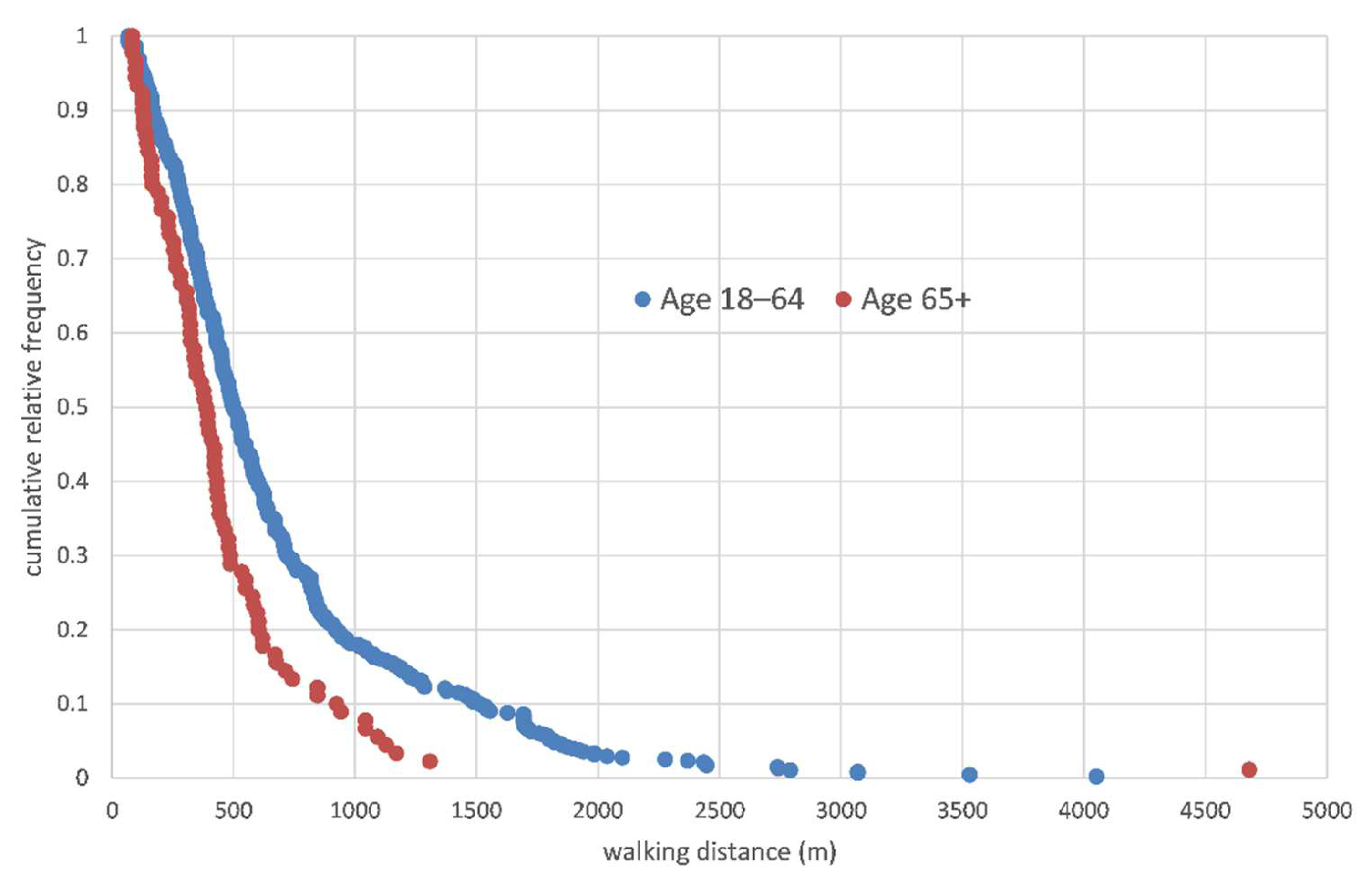
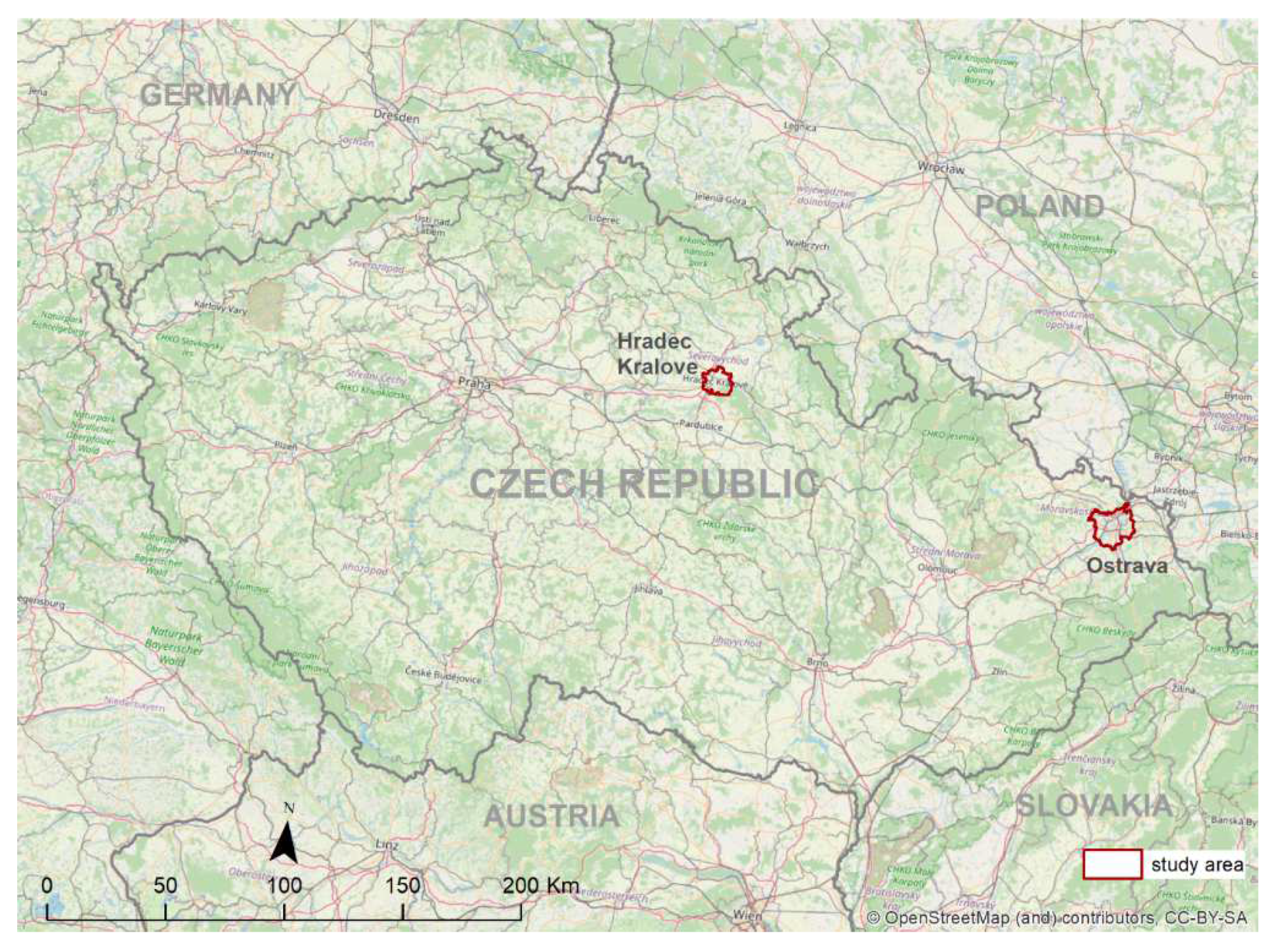

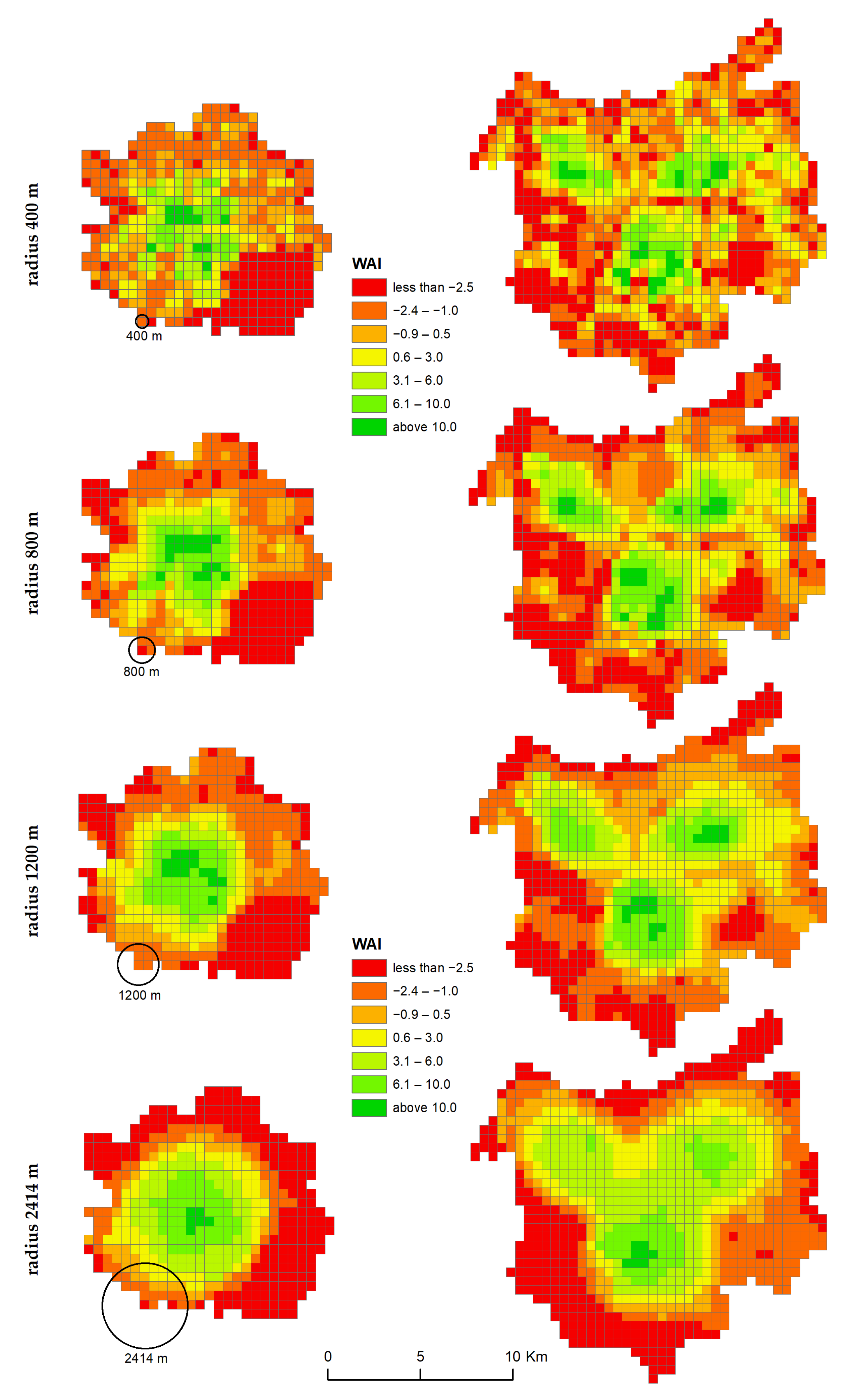
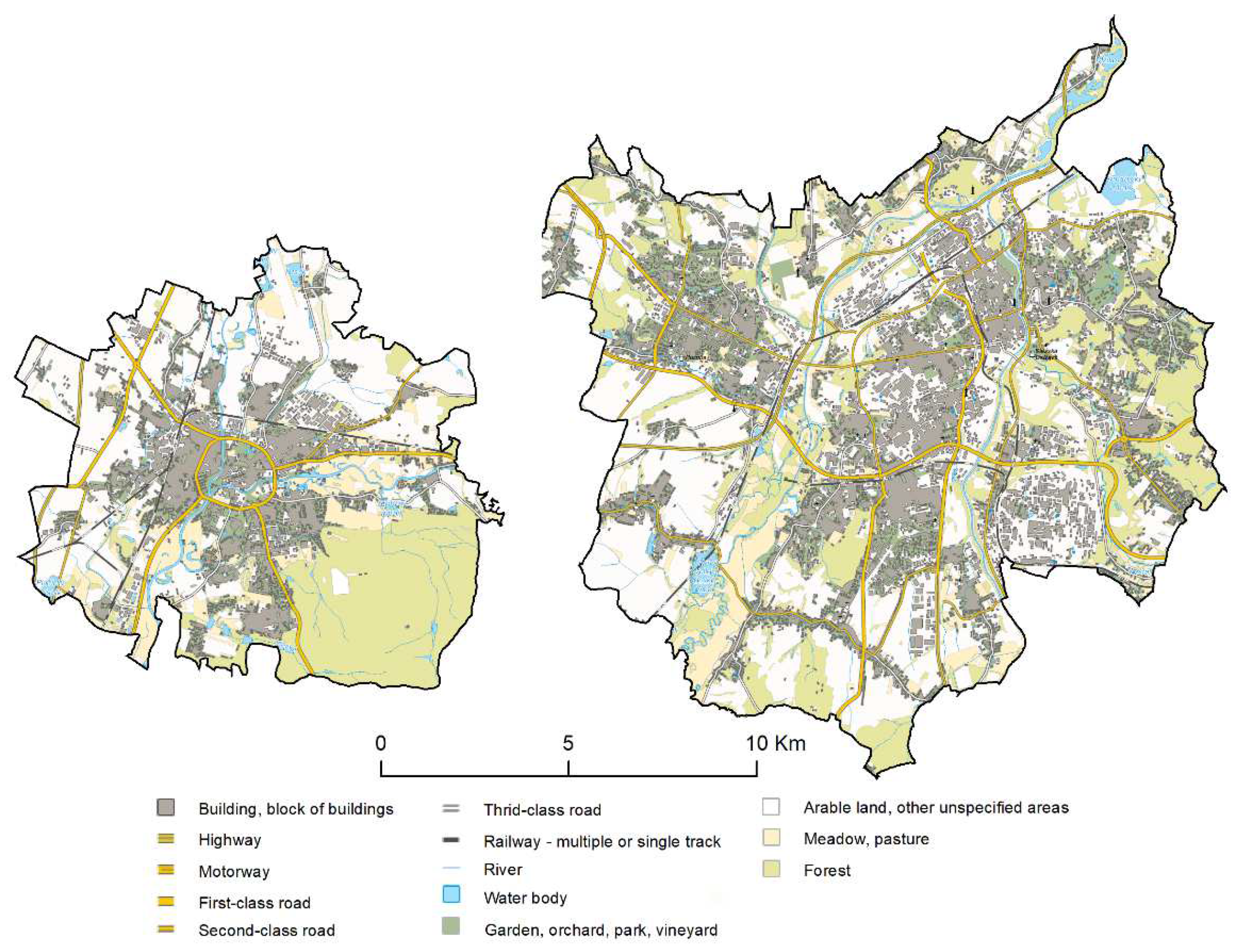
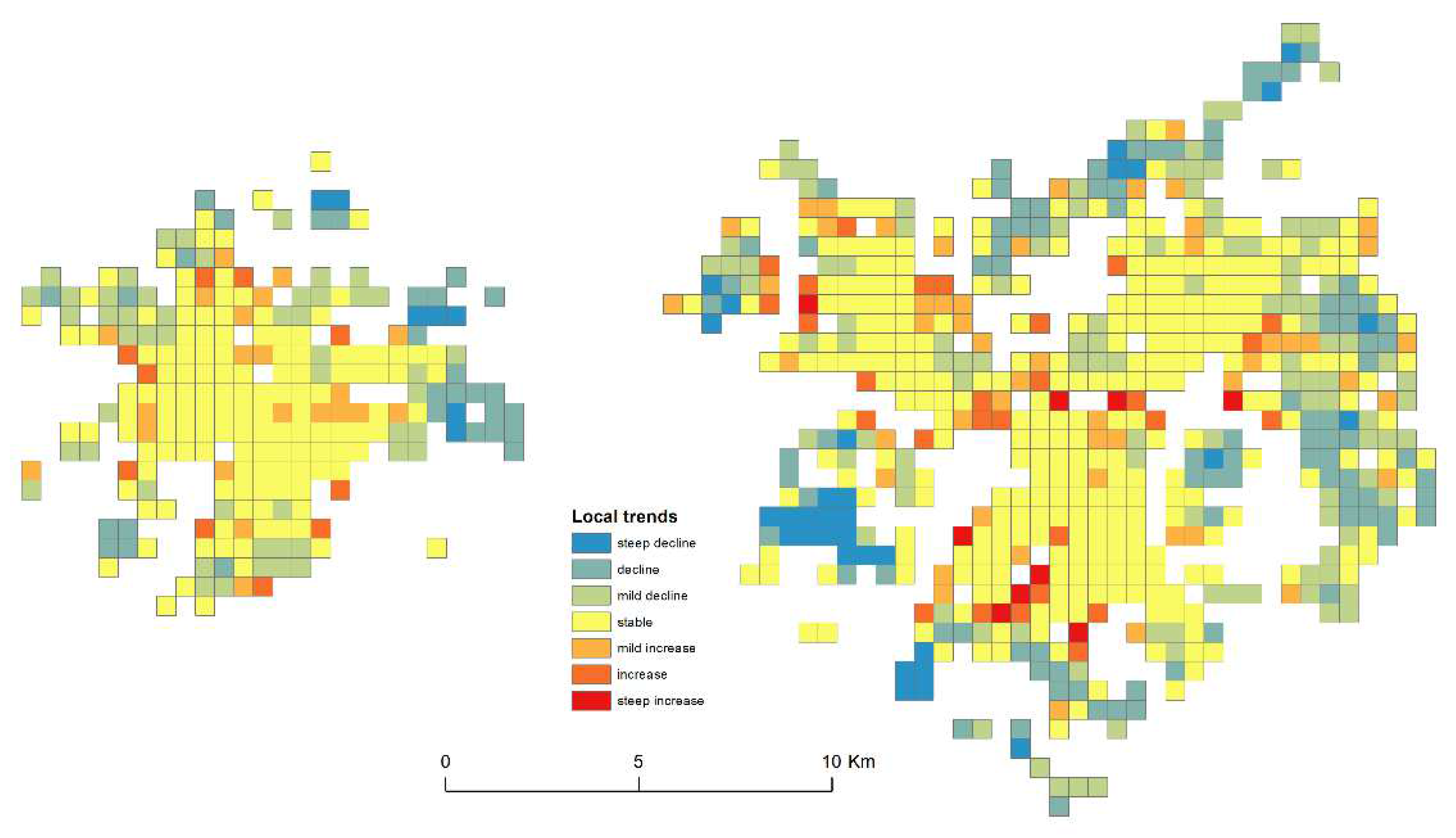
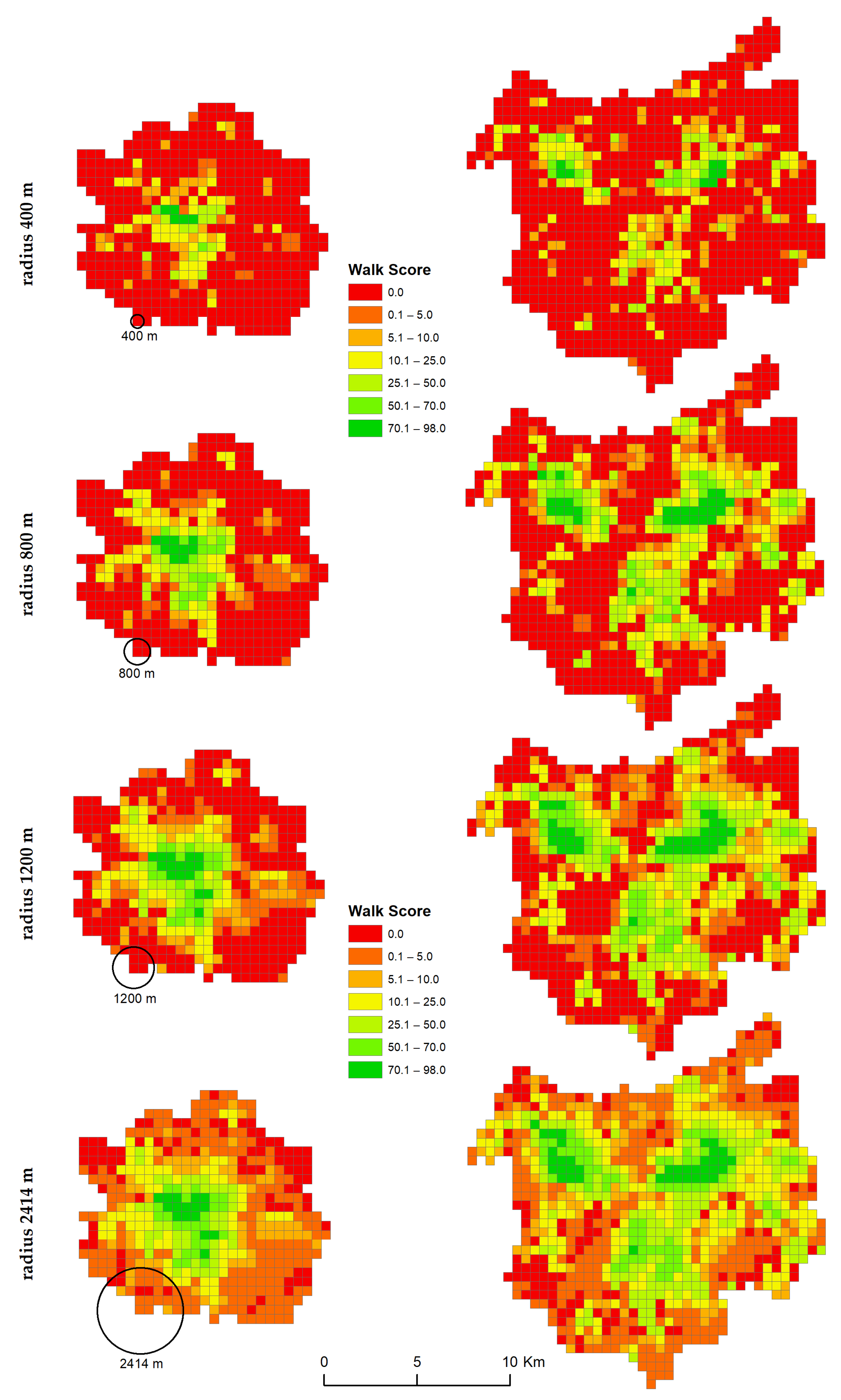
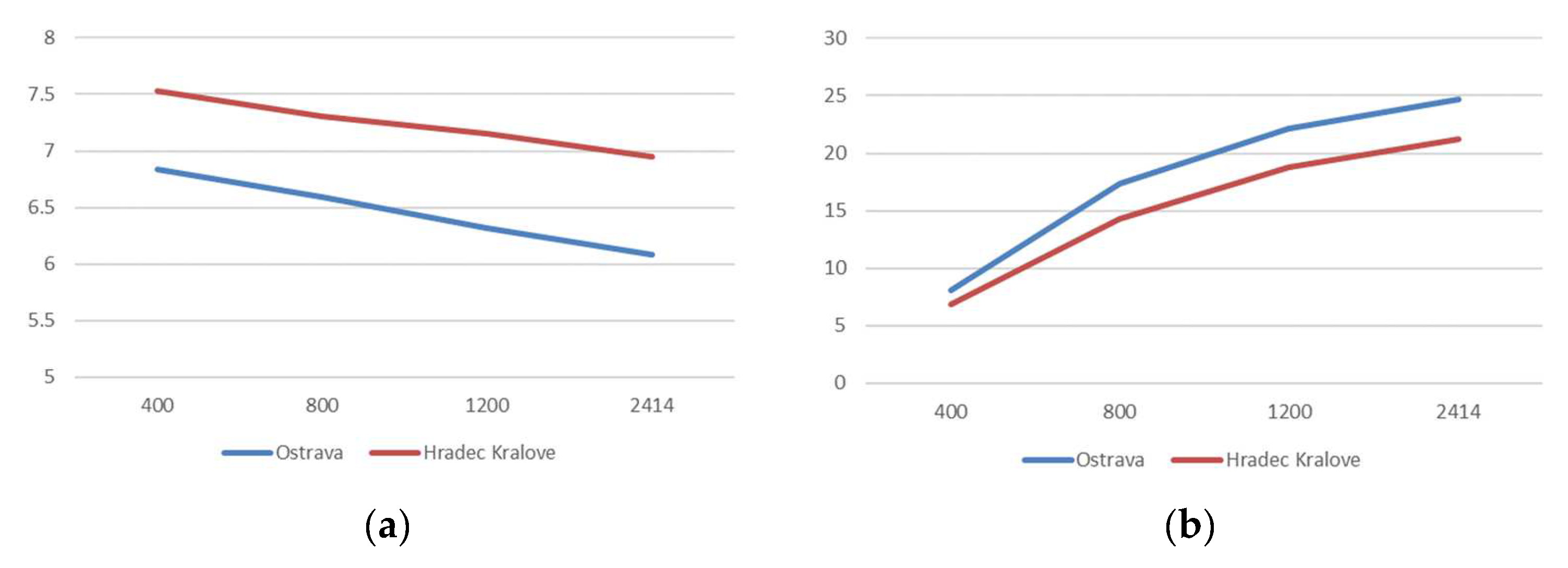
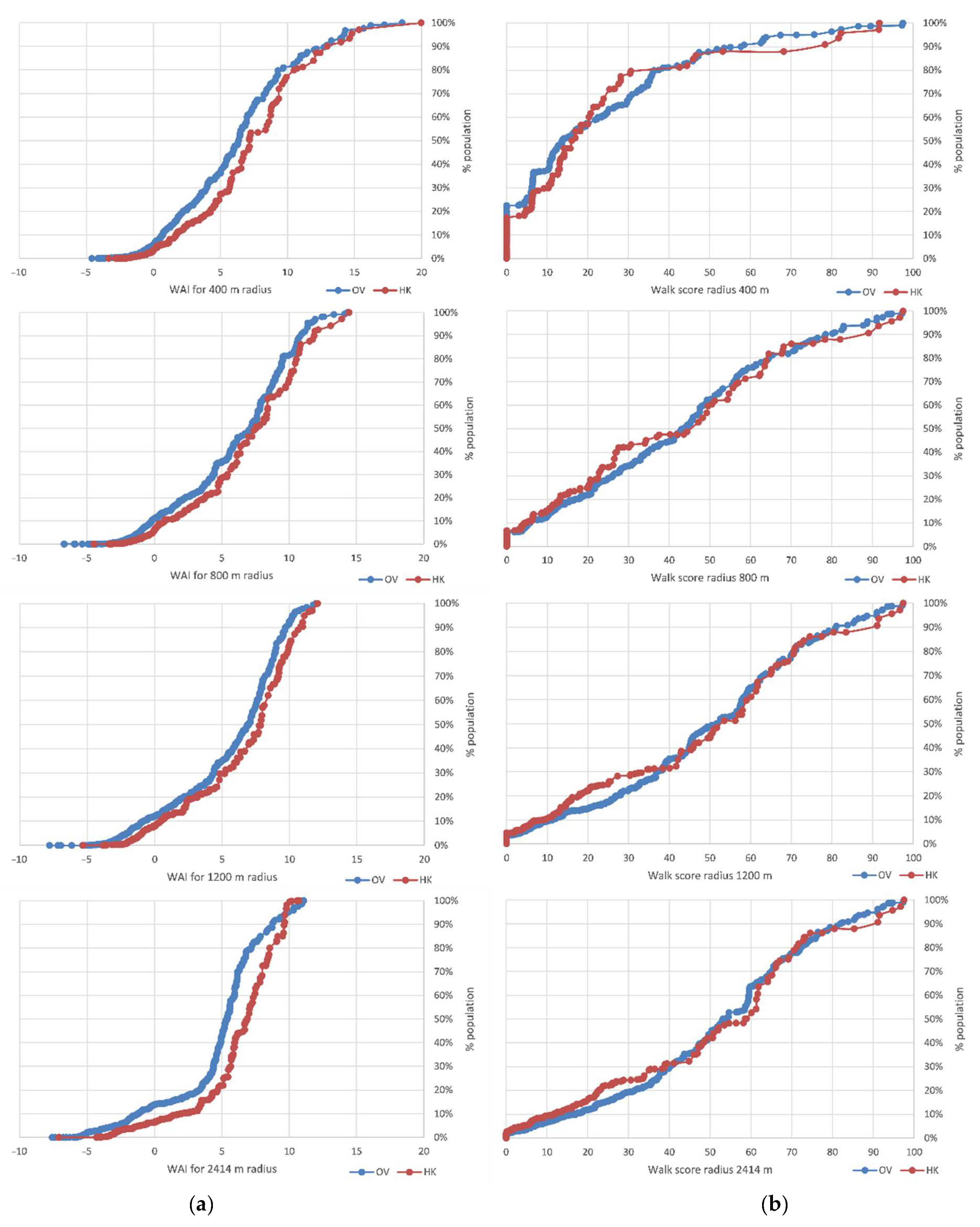
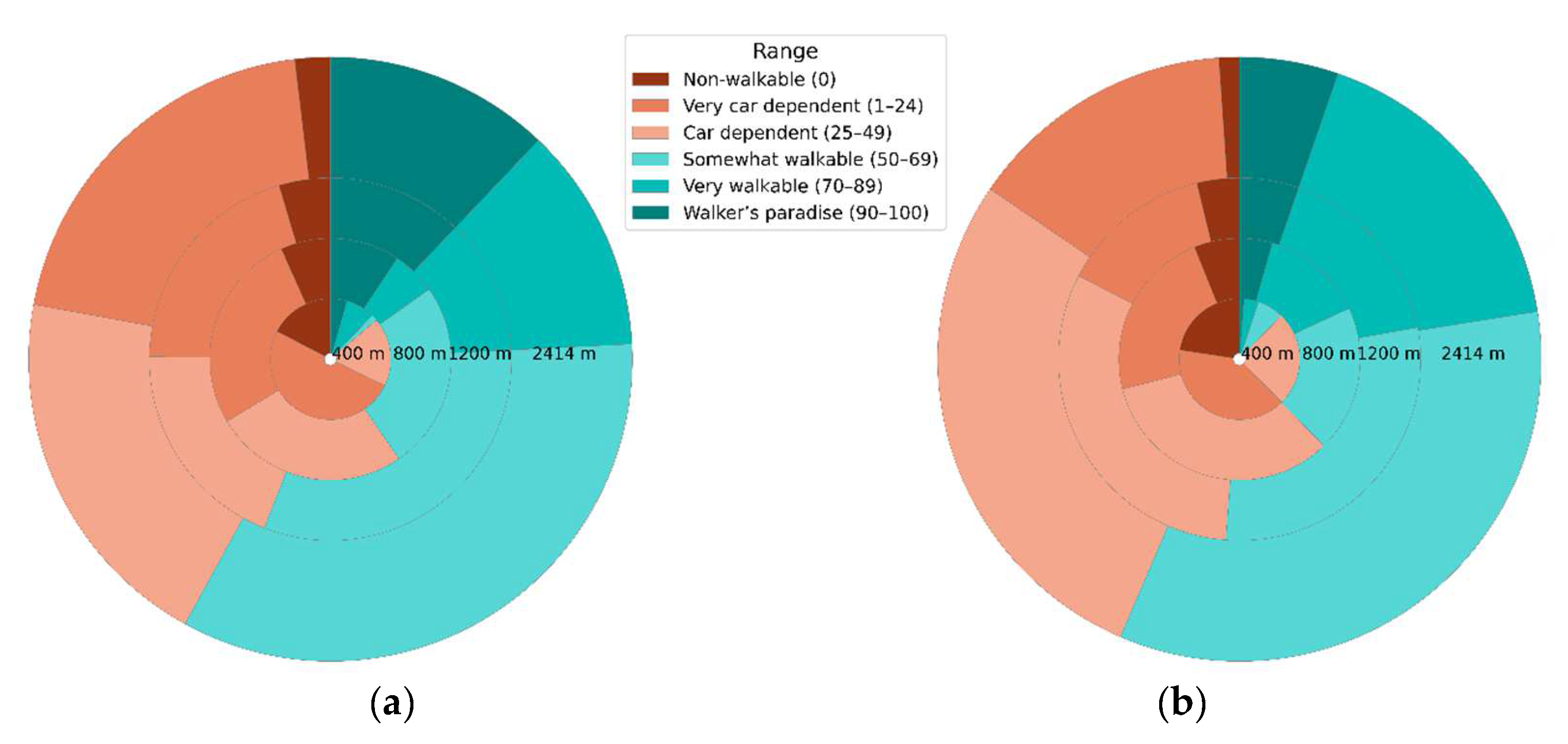

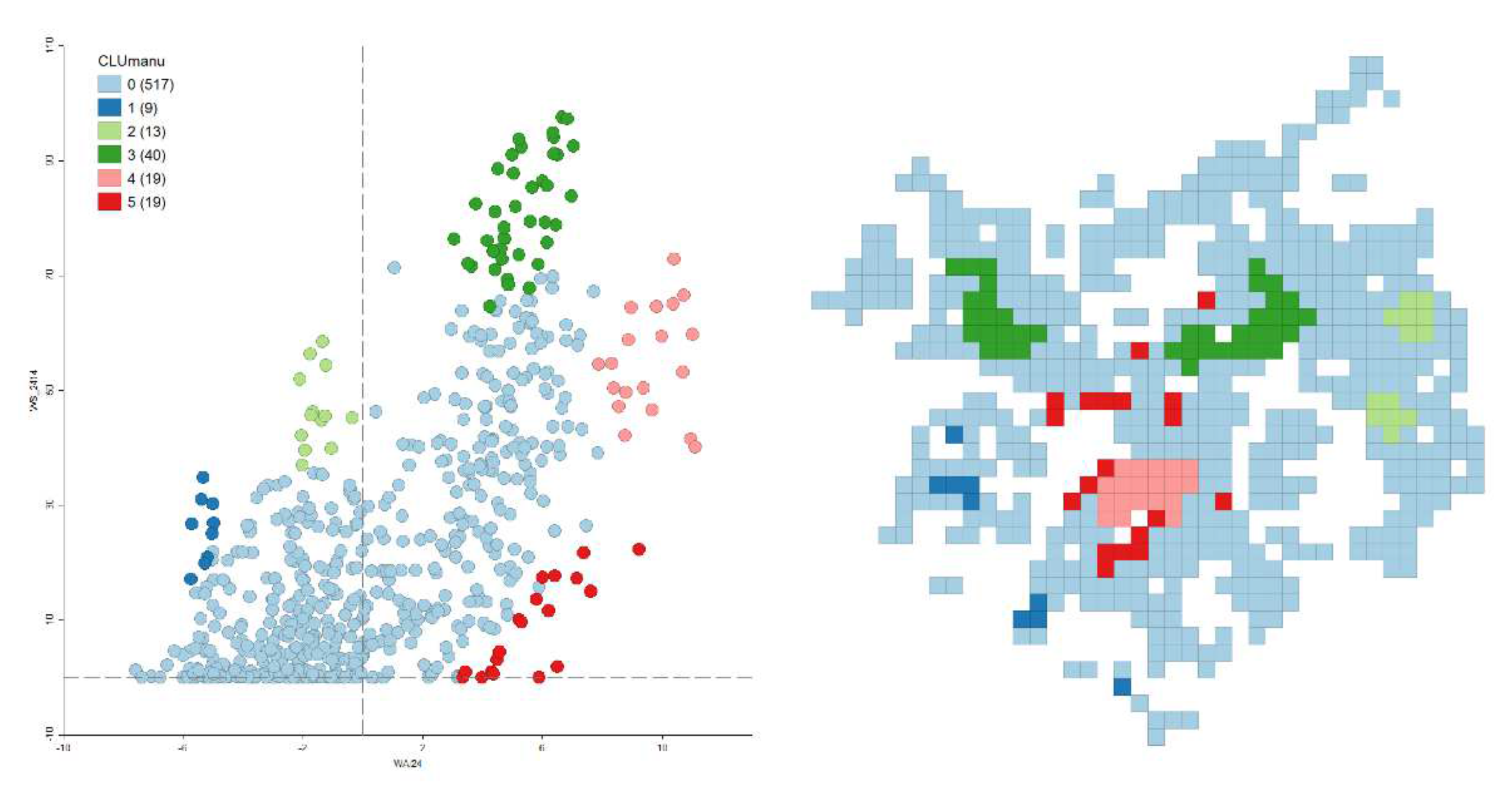
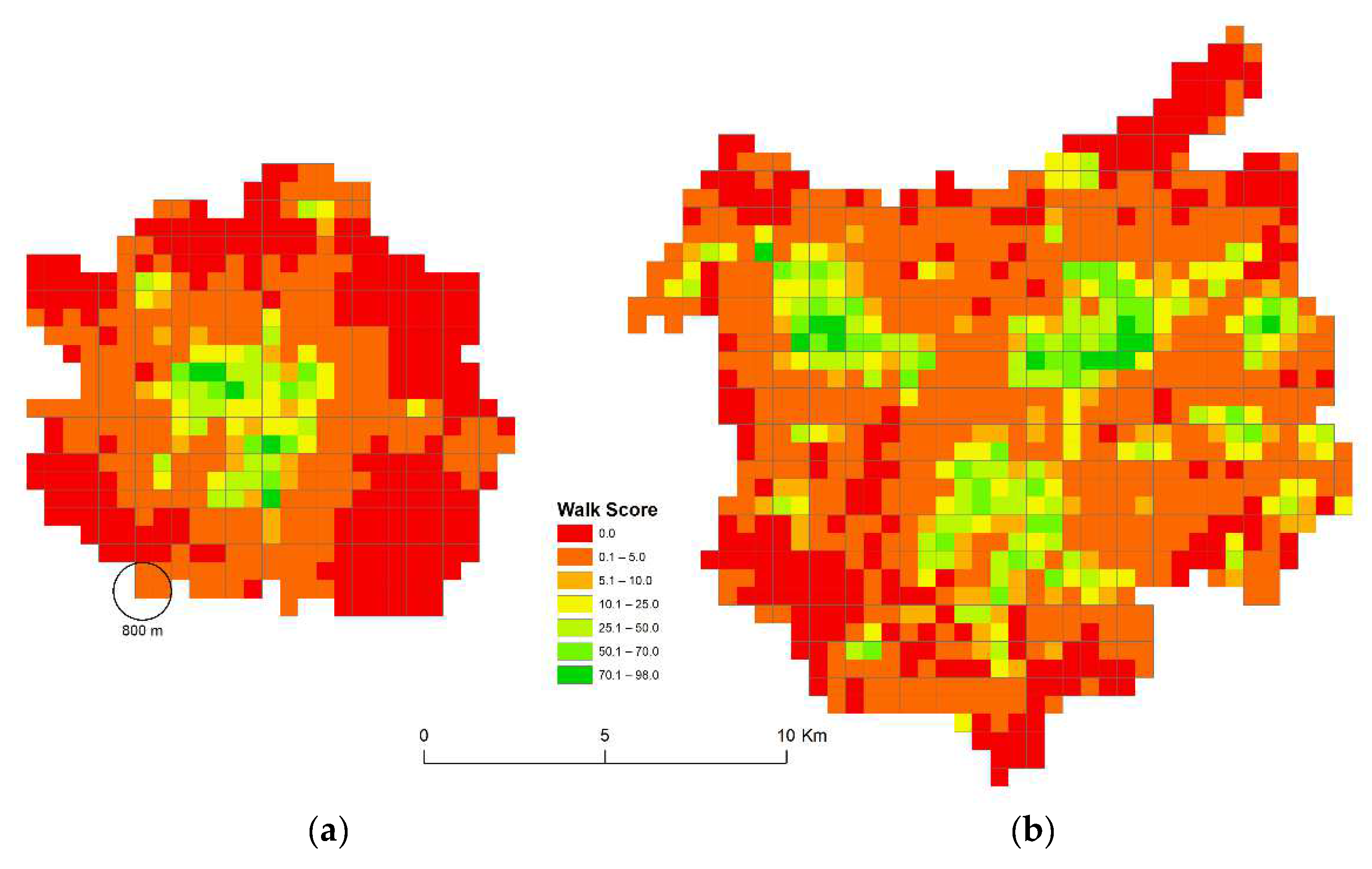
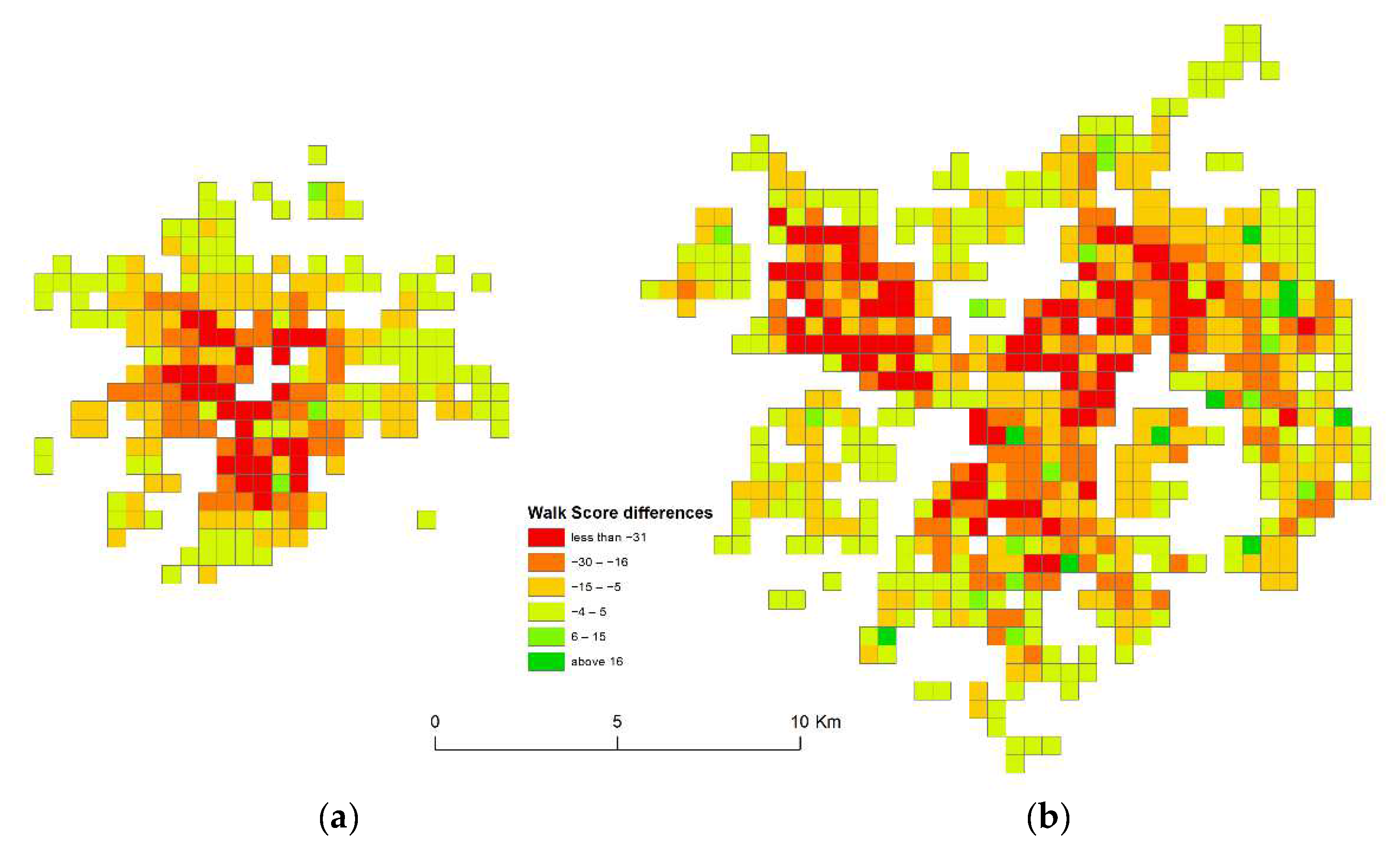
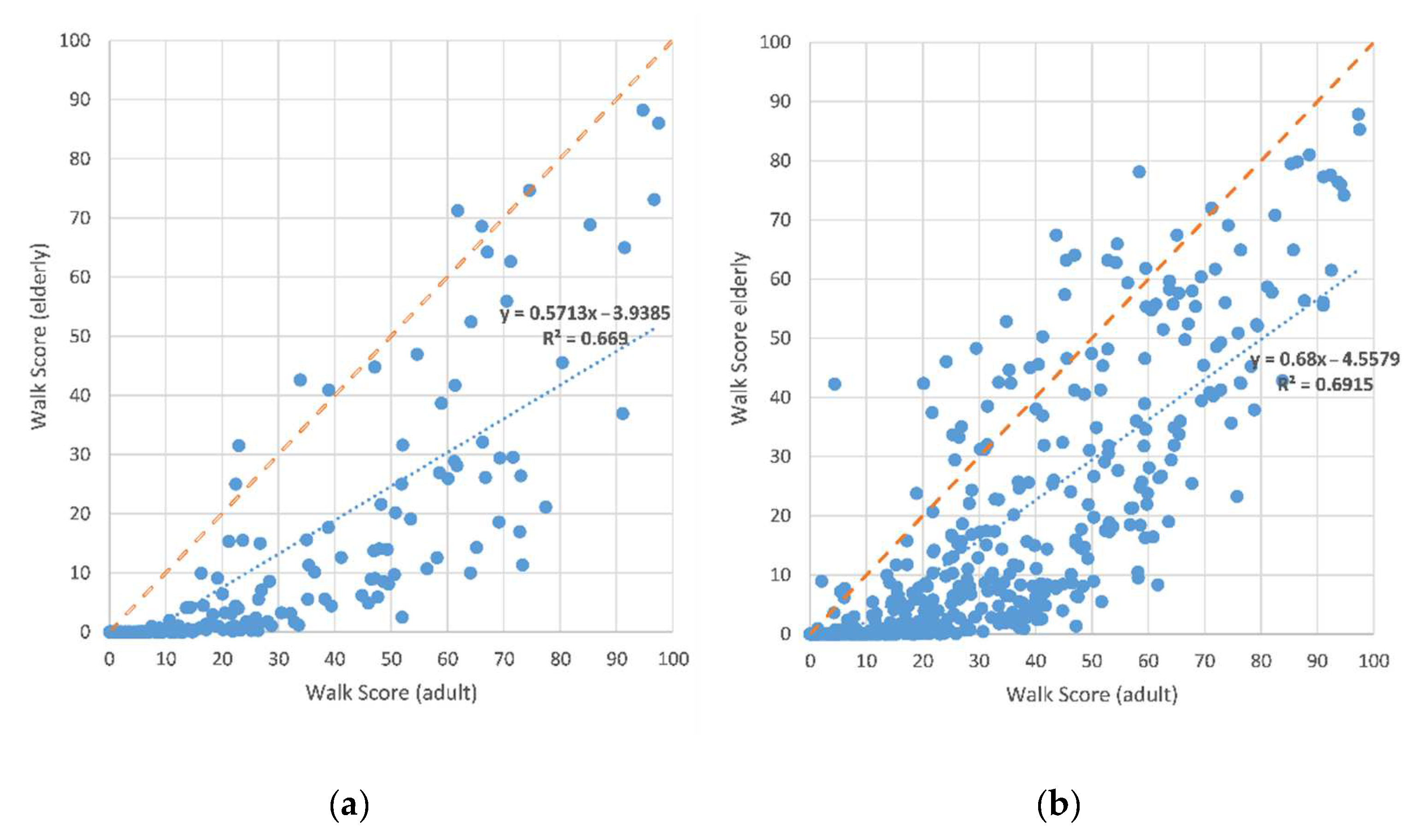


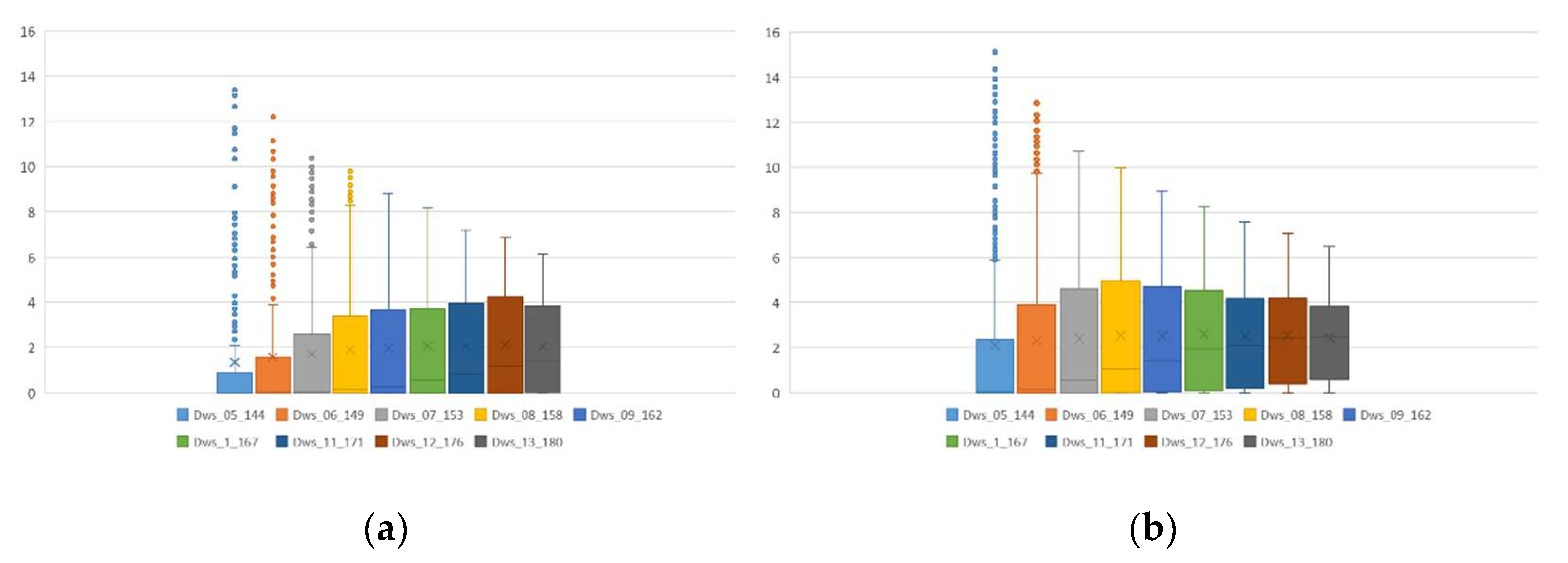
| Horak et al. (2019) | Vidovićová et al. (2013) | |
|---|---|---|
| Visits per Month | Visits per Month | |
| Retail | 7.05 | 11.94 |
| Hypermarket | 4.97 | 1.95 |
| Employment | 1.94 | 4.13 |
| Healthcare | 1.84 | 1.26 |
| Cultural facilities | 1.39 | 0.88 |
| Office | 0.61 | |
| Sport facilities | 0.51 | |
| Cemetery | 0.17 | 0.70 |
| Family | 0.14 | 3.56 |
| Park | 0.08 | 5.75 |
| Garden | 0.06 | 3.61 |
| Cottage | 0.03 | |
| Church | 0.02 | 0.33 |
| City | Range | Share of Units (%) | Share of Population (%) | ||||||
|---|---|---|---|---|---|---|---|---|---|
| 400 m | 800 m | 1200 m | 2414 m | 400 m | 800 m | 1200 m | 2414 m | ||
| OV | High walkability (≥9.28) | 4.5 | 5.5 | 4.4 | 1.8 | 22.1 | 25.6 | 15.3 | 7.9 |
| OV | Low walkability (<9.28) | 95.5 | 94.5 | 95.6 | 98.2 | 77.9 | 74.4 | 84.7 | 92.1 |
| HK | High walkability (≥9.28) | 6.7 | 8.3 | 9.1 | 5.6 | 33.5 | 35.3 | 26.6 | 15.0 |
| HK | Low walkability (<9.28) | 93.3 | 91.7 | 90.9 | 94.4 | 66.5 | 64.7 | 73.4 | 85.0 |
| Range | Share of Units (%) | Share of Population (%) | ||||||
|---|---|---|---|---|---|---|---|---|
| 400 m | 800 m | 1200 m | 2414 m | 400 m | 800 m | 1200 m | 2414 m | |
| Non-walkable (0) | 61.8 | 37.1 | 25.8 | 7.5 | 22.6 | 6.1 | 3.8 | 1.1 |
| Very car dependent (1–24) | 26.7 | 35.5 | 37.1 | 52.5 | 39.8 | 22.9 | 13.6 | 14.4 |
| Car dependent (25–49) | 8.2 | 16.8 | 22.4 | 23.4 | 25.5 | 33.3 | 31.4 | 28.1 |
| Somewhat walkable (50–69) | 1.9 | 5.9 | 9.0 | 10.6 | 7.1 | 19.6 | 29.0 | 34.0 |
| Very walkable (70–89) | 1.1 | 3.2 | 4.2 | 4.5 | 3.9 | 13.7 | 16.9 | 17.2 |
| Walker’s paradise (90–100) | 0.3 | 1.4 | 1.6 | 1.6 | 1.2 | 4.4 | 5.3 | 5.3 |
| Range | Share of Units (%) | Share of Population (%) | ||||||
|---|---|---|---|---|---|---|---|---|
| 400 m | 800 m | 1200 m | 2414 m | 400 m | 800 m | 1200 m | 2414 m | |
| Non-walkable (0) | 61.5 | 42.1 | 28.2 | 11.9 | 17.4 | 6.7 | 4.6 | 1.9 |
| Very car dependent (1–24) | 31.0 | 38.5 | 46.0 | 57.9 | 50.4 | 26.9 | 20.2 | 20.2 |
| Car dependent (25–49) | 4.8 | 9.1 | 11.1 | 14.3 | 18.4 | 26.0 | 19.3 | 19.9 |
| Somewhat walkable (50–69) | 0.8 | 6.7 | 8.7 | 9.9 | 1.7 | 25.2 | 31.8 | 33.8 |
| Very walkable (70–89) | 1.2 | 2.0 | 4.0 | 4.0 | 7.7 | 5.9 | 12.1 | 12.1 |
| Walker’s paradise (90–100) | 0.8 | 1.6 | 2.0 | 2.0 | 4.4 | 9.3 | 12.1 | 12.1 |
| Factor | Values | Step | City | Walk Score Change for 1 Step | ||
|---|---|---|---|---|---|---|
| Mean | 3rd Quartile | 95-Percentile | ||||
| speed | 0.5–1.3 | 0.1 | HK | 1.863 | 3.263 | 7.291 |
| β | 144–180 | 4.5 | ||||
| speed | 0.5–1.3 | 0.1 | OV | 2.436 | 4.258 | 7.742 |
| β | 144–180 | 4.5 | ||||
| retail | 7–12 | 0.55 | HK | 0.253 | 0.111 | 1.509 |
| OV | 0.402 | 0.431 | 2.102 | |||
| hypermarket | 1–5 | 0.44 | HK | 0.019 | 0.000 | 0.090 |
| OV | 0.017 | 0.000 | 0.068 | |||
| entertainment | 0.8–1.4 | 0.07 | HK | 0.008 | 0.000 | 0.043 |
| OV | 0.010 | 0.000 | 0.058 | |||
| doctor | 1–2 | 0.11 | HK | 0.033 | 0.012 | 0.208 |
| OV | 0.039 | 0.034 | 0.216 | |||
| park | 0.1–6 | 0.66 | HK | 0.467 | 0.575 | 2.468 |
| OV | 0.263 | 0.121 | 1.555 | |||
Publisher’s Note: MDPI stays neutral with regard to jurisdictional claims in published maps and institutional affiliations. |
© 2022 by the authors. Licensee MDPI, Basel, Switzerland. This article is an open access article distributed under the terms and conditions of the Creative Commons Attribution (CC BY) license (https://creativecommons.org/licenses/by/4.0/).
Share and Cite
Horak, J.; Kukuliac, P.; Maresova, P.; Orlikova, L.; Kolodziej, O. Spatial Pattern of the Walkability Index, Walk Score and Walk Score Modification for Elderly. ISPRS Int. J. Geo-Inf. 2022, 11, 279. https://doi.org/10.3390/ijgi11050279
Horak J, Kukuliac P, Maresova P, Orlikova L, Kolodziej O. Spatial Pattern of the Walkability Index, Walk Score and Walk Score Modification for Elderly. ISPRS International Journal of Geo-Information. 2022; 11(5):279. https://doi.org/10.3390/ijgi11050279
Chicago/Turabian StyleHorak, Jiri, Pavel Kukuliac, Petra Maresova, Lucie Orlikova, and Ondrej Kolodziej. 2022. "Spatial Pattern of the Walkability Index, Walk Score and Walk Score Modification for Elderly" ISPRS International Journal of Geo-Information 11, no. 5: 279. https://doi.org/10.3390/ijgi11050279
APA StyleHorak, J., Kukuliac, P., Maresova, P., Orlikova, L., & Kolodziej, O. (2022). Spatial Pattern of the Walkability Index, Walk Score and Walk Score Modification for Elderly. ISPRS International Journal of Geo-Information, 11(5), 279. https://doi.org/10.3390/ijgi11050279






